Dishes with phyllo dough. Do you like flour products? How to make phyllo dough
Love flour products and have you already tried a lot of recipes? If you have patience, strength and free time, then try making phyllo dough. It should be said right away that this is not easy. But the result will exceed all your expectations!
What kind of dough is this?
Filo dough is a stretched, unleavened, very thin dough that belongs to the national Greek cuisine and is usually used to prepare dishes such as tiropita, bureka, baklava and so on. By the way, the name can be literally translated as “leaf”. There is approximately the same recipe in Turkish cuisine, but there this dough is called “yufka”.
Classic phyllo is usually made from flour, water, olive oil, as well as vinegar (most often wine). But every Greek housewife has her own tricks that she doesn’t reveal to anyone. First, the dough is kneaded, then rolled out and stretched to a minimum thickness. In pastry shops they use specialized machines for rolling, but at home you will have to try and make your own efforts.
How to cook?

How to make phyllo dough? To do this you will need:
- 3 cups flour;
- 1 glass of water;
- 50 ml olive oil;
- 2 tablespoons of high-quality wine vinegar;
- 1 teaspoon of salt (without a slide).
Step-by-step instruction:
- First you need to sift the flour and mix it with salt. Place it in a fairly deep and wide bowl and make a well in the center.
- Pour warm water and oil, as well as vinegar, into the hole.
- First, knead the dough with a spoon or fork, gradually combining the liquid ingredients with the bulk ones. When a ball begins to form, continue kneading the phyllo with your hands.
- Knead the dough until it is smooth, this may take about 10 minutes. As a result, you should get an elastic, resilient, soft and plastic mass.
- Now cover the bowl with something (for example, a towel) and let the dough stand for a while. room temperature about an hour for it to “distance”.
- Divide the total volume into approximately 15 parts (everything will depend on the number of sheets needed for preparing the dish, as well as their size).
- Take the first piece and place it on a table sprinkled with flour (otherwise the phyllo will stick). Next, roll out the dough into a thin layer and periodically stretch it with your hands. The sheet should become very thin, almost translucent.
- Place the first sheet on parchment and cover with parchment on top.
- Roll out the layers, stack them, alternating with sheets of parchment so that they do not dry out or stick together.
- When all the layers are ready, start preparing the dish.
How to use the dough?

You can cook a wide variety of phyllo flour dishes. Below are the most popular and successful recipes.
Recipe No. 1
You will need:
- 12 sheets of rolled out phyllo dough;
- 2 apples;
- 50 grams of walnuts;
- 50 grams of raisins;
- 5-6 tablespoons of sugar;
- ½ teaspoon cinnamon;
- 50 grams of butter.
Preparation:
- First make the filling. To do this, peel and finely chop the apples. Chop the nuts and pour boiling water over the raisins for literally ten minutes until they become soft. Mix it all, add sugar.
- Take one sheet of phyllo, spread it out and grease it butter(after melting it). Place the second layer on top and grease it too. Lay 4 sheets in this manner, greasing each one with oil.
- Place the filling on the edge of the four-layer layer, bend the edges slightly along the width so that the juice does not leak out during the cooking process. Roll the dough with the filling into a roll.
- Also form the remaining strudels (there will be 3 in total) and bake them at 180 degrees for about 25 minutes.
Recipe No. 2
Prepare the following ingredients:
- 250 grams ready dough filo;
- 100 grams of peanuts;
- 100 grams of walnuts;
- 2 tablespoons sugar;
- ½ teaspoon cinnamon.
For the syrup:
- 150 grams of sugar;
- ½ teaspoon cinnamon;
- 50 grams of honey;
- 50 ml water;
- 1-2 teaspoons lemon juice.
Preparation:
- First, start preparing the filling. Chop the nuts (peanuts can be lightly fried in a dry frying pan). Mix nuts with sugar.
- Now make the syrup. To do this, in a thick-bottomed saucepan, combine water, sugar, lemon juice, cinnamon and honey. Bring this mixture to a boil and cook, reducing heat, until thickened.
- The butter needs to be melted, it will be needed to grease the dough.
- Now you can start forming the baklava. To do this, take a rectangular baking dish corresponding to the size of the dough sheets, grease its bottom and walls with oil.
- Next, place three layers of phyllo, brush with butter, place a layer of nuts on them, then place three sheets of dough again. Layer the layers so that the phyllo ends up last. Grease the surface with oil, cut the baklava into rectangles and bake at 180 degrees for about 15 minutes.
- Pour syrup over the finished baklava.
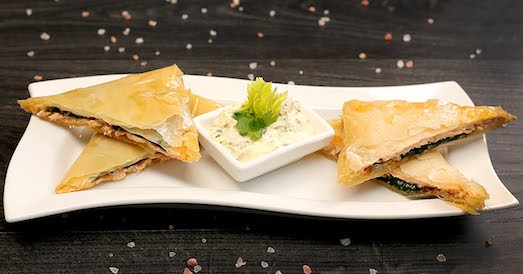
Some useful tips, which will simplify the preparation process as much as possible, and also improve the taste of the finished dough:
- Be sure to sift the flour, otherwise the dough will be tough.
- If you have leftover homemade filo, don’t rush to throw it away; it keeps well in the freezer for up to three months. Just wrap it in film and roll it into a roll.
- If you are using previously frozen dough, then defrost it completely before cooking, and only at room temperature! Cold and not fully defrosted dough is very brittle and almost impossible to work with.
- Before cooking, it is advisable to heat the water and oil, then the dough will be more elastic and soft.
- If the dough breaks (this often happens with beginners), then add one or two egg whites(and some, on the contrary, use yolks), they will make the filo more viscous and combine all the ingredients.
- You can substitute vinegar if desired. citric acid, it has the same properties and performs the same functions in the test.
- Do not freeze the dough twice; it will lose its properties, the most important of which is elasticity.
- The dough may tear the first few times. But over time, you will get used to it and learn to literally feel the phyllo and control the stretch. Everything will come with experience.
If you master this dough, you will be able to prepare a lot interesting dishes for the whole family go guests.
“A hut is not red in its corners, but in its pies,” says the Russian proverb... And today we are baking Greek pies!
Let's start with the test. Almost all pies: both sweet and savory unsweetened filling, the Greeks bake with filo dough (Filo or Phyllo).
Filo dough is frozen thin sheets unleavened dough. When preparing pies, the layers of dough are defrosted, then each layer is lightly greased with melted butter, the next layer is applied, it is again greased with butter, etc. At least ten layers of dough are used for the bottom of the pie, and the same amount for the top. Connoisseurs of Greek cuisine advise brushing the dough layers with melted butter or creamy margarine, despite the fact that in some recipes there are recommendations to grease the dough sheets with olive oil. If you use vegetable oil, then each plate of dough is covered with a hard crust and remains raw inside. To lubricate the plates, use either a bird feather or a soft brush so that the oil is distributed evenly between the layers and there is no excess. Since the dough has a bland taste, it is recommended to use salted butter to lubricate the layers when preparing pies with savory filling.
Typically, ready-made filo sheets are sold in Greek grocery stores or supermarkets in closed plastic boxes of 24-30 sheets of dough per package. In such a box, each layer is arranged thin piece polyethylene, which prevents the dough from sticking together. Filo dough is stored only in the freezer, since it defrosts in the refrigerator in about 8-9 hours (before preparing pies, the box of dough should be removed from the freezer and placed overnight in refrigerator), and only in a closed box, since in the air the dough instantly begins to dry out, becomes crusty and loses its elasticity. Because of its last feature, it is recommended to work with the dough quickly and smoothly. Before you take it out of the refrigerator and expose it to the air, you should prepare everything necessary supplies for making pies: melt the butter, remove the brush for greasing from the shelf, preheat the oven to desired temperature, sprinkle the table or board on which you will lay out the layers of dough with flour, grease the baking dish and, of course, prepare the filling in advance. If you need to take a break while layering, cover the dough with a damp towel to prevent it from drying out.
Since the layers of phyllo dough are very thin, pies with such dough bake very quickly, so the filling for such pies should already be ready. Raw meat or vegetables are never wrapped in this dough! The filling for such pies should not be wet, as the escaping steam can easily break through the thin layers of dough.
Cook pies at a temperature of 180 - 200 degrees for no more than 30 minutes. If you cook a filo pastry pie over low heat, it will take more than long time, it will not bake and will be raw.
And the final touch to the portrait of filo dough. Since the dough loves to be frozen, you can prepare it in advance and store it in the freezer for up to six months. In this case, you can freeze not only the dough, but also ready-made pies and pies. Even already baked pies can be frozen. Cooking frozen pies does not require pre-defrost. You can place the frozen pie directly into hot oven, but in this case they should slightly increase the baking time. Already baked frozen pies are heated in the oven at 160 degrees for several minutes until the pies are hot.
Buying dough in Russia is difficult, if not impossible, but it is possible to prepare it yourself. If you don’t want to bother with preparing phyllo, you can use ready-made puff pastry, which is what I usually do with success. However, puff pastry is more delicate and lighter than phyllo dough, therefore, using puff pastry, you can only get an analogue of the original Greek pies. For experienced cooks, here is the recipe:
5 cups sifted wheat flour;
5 tablespoons of olive oil;
2 1/2 cups water (approx);
salt;
2 tablespoons vinegar (4.5%)
Leave a little flour (no more than 1/2 cup), we will need it for adding when rolling out the layers. Mix the rest of the flour, olive oil, salt, water and vinegar. soft dough. Roll the dough into a ball, wrap the dough in a bag and place it in the refrigerator, in the coldest compartment, for example, on a shelf under the freezer, for one hour. After an hour, sprinkle the surface on which you will roll out the dough layers with flour, remove the dough from the refrigerator and divide it into 20 equal parts. Roll out each piece into a thin sheet, approximately 2-3 mm thick. When rolling out the next part, cover the already rolled part with a damp towel, and put the pieces of unrolled dough in a bag and keep it in the refrigerator.
If desired, the recipe can be slightly modified by adding two raw eggs and reducing the amount of water to 1 1/2 cups. This “butter” dough is best suited for pies with vegetable fillings.
And now, finally, recipes for Greek pies that use phyllo dough. The Greeks usually bake either large rectangular closed pies, for which rectangular deep forms for baking, resembling large metal trays, or small triangular pies. You can bake all the pies, the recipes for which are given below, both large and small. It’s whatever your heart desires!
TIROPITA
For filling:
400 g feta cheese;
4 tablespoons melted butter or margarine;
200 grams of “Homemade” cheese;
5 eggs;
1/2 cup finely chopped parsley;
a little dill;
a little ground black pepper;
nutmeg- on the tip of a knife
If the cheese is very salty, cut it into large slices and soak in water for 4 hours, then mash it into fine crumbs with a fork, add Domashny cheese, eggs and grind the filling into a paste. Then add parsley, dill, pepper and nutmeg and mix everything thoroughly.
Now prepare the phyllo dough and place 10 sheets in a baking dish, brushing each one with melted butter or margarine, the edges of the dough should extend beyond the side of the form. If you use frozen puff pastry, then for this amount of filling you will need 500 grams (one package) of dough. Divide the dough into two parts (one should be slightly larger than the other). Roll out most of it and place it in the mold, leaving the edges of the dough so that they slightly extend beyond the side of the mold.
Spread the prepared cheese filling in an even layer. Cover the filling with the remaining dough (if using phyllo, place 10 more layers of dough on top, brushing each with butter) and seal the edges to make it closed pie. Grease the surface of the pie with oil and bake at 180 degrees for 20-25 minutes.
Tiropita is served warm.
SPANAKOPITA
butter or margarine for greasing the dough layers;
For filling:
500 grams of green spinach (you can use frozen);
olive oil (no more than 1/2 cup);
2 large onions;
2 cloves of garlic;
400 g feta cheese;
2 eggs;
half a teaspoon of nutmeg;
salt, pepper to taste;
a little any greens (coriander, basil, dill, parsley)
Sort the spinach leaves and rinse well. Bring water to a boil in a large saucepan, add spinach leaves and cook until soft. Then remove the spinach, cool and chop finely. If you are using frozen spinach, defrost it first and then boil it in hot water. Finely chop the onion and garlic and fry in a frying pan in olive oil.
TIP: When frying onions and garlic together, add the garlic to the onions at the very end, when the onions are almost ready. If you saute the onion and garlic for as long as it takes to cook the onion, the garlic will burn and give the dish a bitter taste. If you shorten the cooking time for the onions, focusing on the garlic, the onions will not cook through and, accordingly, will also spoil the taste of the dish.
Add the spinach to the onion and garlic and simmer the mixture for about 15 minutes until all the excess moisture has evaporated from the spinach, stirring occasionally. Remove the pan from the heat and cool its contents. Then add finely chopped herbs, nutmeg and eggs to the spinach (no need to add salt!), and mix everything carefully. Mash the cheese into crumbs and add to the rest of the ingredients. Lightly pepper the spinach mixture; if it is not salty enough, add salt and stir again. The filling is ready.
Now grease the baking dish with oil. Lay out the dough (see previous recipe). To make spanakopita you will need 1 kg of filo dough (20 sheets, 10 sheets each for the bottom and top layers of dough) or 1 kg of puff pastry (two packages of ready-made dough). Place the prepared filling on the dough, cover it with the remaining dough and form a closed pie. Grease the spanakopita with butter and bake in the oven at 180 degrees for 30 minutes.
Spanakopita is served hot.
Tip: Once, my friend and I decided to treat our friends to spanakopita, but, unfortunately, the store didn’t even have frozen spinach. I had to buy a package of broccoli. As a result, we got very original pie, but the taste of broccoli slightly drowned out all the other ingredients.
CREATOPITA
Kreatopita – Cretan meat pie. Since there are many filling options for creatopita, we offer you two of the most interesting ones.
Option 1:
phyllo dough or ready-made puff pastry (500 g);
butter or margarine for greasing the dough layers;
For filling:
3 tablespoons butter or margarine;
a bunch of green onions (or shallots);
500 grams of lamb or beef;
1/2 cup dry white wine;
1 heaping tablespoon of finely chopped parsley;
1 tablespoon finely chopped fresh mint leaves (if you are using dry mint, you need to take 1 teaspoon, as dry mint has a stronger aroma);
1 tablespoon of finely chopped dill;
1/2 cup tomato sauce ( tomato paste diluted with water to form a sauce);
salt and pepper to taste;
1/2 cup grated sharp cheese;
1 egg;
1 tablespoon bread crumbs (if needed)
Pass the meat through a meat grinder. Melt the butter in a thick-bottomed pan and fry the finely chopped green onions. Add chopped meat, fry the meat until it turns brown, stirring with a fork so that the minced meat does not stick together in lumps. Add wine and boil for a few minutes. Then add parsley, mint, dill and tomato sauce, add salt and pepper and simmer for another 20 minutes or until all the liquid has evaporated. After this, remove from heat, cool, add cheese and egg, and mix everything well. If the filling still turns out runny, add bread crumbs, which will take away excess moisture.
Now we prepare the pie for baking. Place the layers of dough in a greased pan in the same way as written in previous recipes, put the filling on the dough, cover it on top with the remaining layers of dough and form a closed pie. Grease it with butter and bake at 180 degrees for 20-25 minutes or until the pie is covered with a golden crust.
Option 2:
phyllo dough or ready-made puff pastry (1 kg);
butter or margarine for greasing the dough layers;
For filling:
1 1/2 kg lamb or beef;
1 kg of onion;
2 bouillon cubes (beef);
4 tablespoons butter;
10 eggs;
1 tea cup of milk;
2 tea cups of semolina;
salt, pepper to taste;
cinnamon
Pass the meat through a meat grinder, finely chop one onion. Half specified quantity Melt the butter in a thick-bottomed saucepan and fry the onion until soft. Add minced meat, salt, pepper, cinnamon, 1.5 cups hot water and simmer the meat until all the liquid has evaporated.
Peel the remaining onions, cut each into four parts and cook the onions in broth made from bouillon cube until soft. You can prepare broth from lamb or beef bones in advance, then the pie will turn out tastier. Remove the prepared onion from the broth and puree through a sieve.
Separate two teaspoons of the broth in which the onions were cooked. Weld semolina porridge, using two cups of broth and a cup of milk, and then refrigerate it. Add onion puree, eggs, remaining butter, cinnamon, salt and pepper to taste.
Place the layers of dough in a greased form, so that the edges protrude beyond the side, coat each layer with oil. Place the meat filling on top of the dough and meat filling- semolina filling. Cover with the remaining layers of dough, again oiling each one. Protect the edges of the pie so that you get a closed pie, grease the top of the pie with butter and bake in the oven at 180 degrees until the pie is covered with a golden crust.
GALACTOBOURIKO
1 kg filo dough;
1/4 cup unsalted butter for brushing the layers;
For filling:
3 eggs;
1/2 cup sugar;
1/5 cup semolina;
1 3/5 cups cream;
3-4 drops of vanilla essence (can be replaced with vanilla);
30 g butter;
for syrup:
1/5 glass of water;
lemon peel;
150 grams of sugar;
1 tablespoon lemon juice
If in previous recipes filo dough could easily be replaced with regular puff pastry, then in this recipe, and also in the following, you will not be able to simplify the procedure for preparing a sweet dessert pie in this way, since in both cases the already baked pies will have to be soaked in syrup, which will make the already soft and airy puff pastry too soft and moist.
Let's prepare the filling. Bring the milk to a boil and cook the semolina porridge for 5 minutes, stirring constantly. Remove the pan from the heat, add butter to the porridge and leave to cool for 10 minutes. Beat the eggs with sugar until they turn into a homogeneous, fluffy mass. Then add the beaten eggs to the cooled porridge, add vanilla essence, and beat well again. Place the pan on the fire and keep it on the fire for 2-3 minutes, without ceasing to whisk the contents of the pan. Remove the pan from the heat and leave. The filling is ready. While preparing the pie, stir the semolina cream several times to form a crust on its surface.
Grease the baking dish with oil. Lay out 10 layers of phyllo dough, buttering each one. Then spread the semolina cream on the dough and cover it with another 10 oiled dough sheets. We form a closed pie, grease its surface with butter and bake in a well-heated oven at 180 degrees for 45 minutes.
After 45 minutes, remove the pie from the oven and set to cool for 10 minutes, meanwhile prepare the syrup. Dissolve sugar in water and add lemon peel and lemon juice. Boil the syrup over low heat for 5-7 minutes until it thickens. Let the syrup sit for 5 minutes, then remove the lemon peel from it and carefully pour it onto the pie, spreading the syrup over the entire surface. When all the syrup is absorbed, the galactoouriko is ready. Cut it into small pieces and serve.
BACLAVAS
500 g filo dough;
400 grams of ground almonds;
2 teaspoons cinnamon;
a pinch of ground cloves;
1 cup butter;
2 cups sugar;
1 glass of liquid, uncandied honey;
fresh lemon juice;
2 teaspoons vanillin or vanilla essence
To prepare baklavas, they usually use at least 40 sheets of phyllo dough, although if you are preparing this dish for the first time, you can get by with twenty.
Mix almonds, cinnamon and cloves. Grease a baking dish with butter and place 4 sheets of phyllo dough in it, brushing each with butter. Grease the fourth (top) layer with butter and sprinkle with a thin layer of the nut mixture. Then lay out 2 sheets of dough, sprinkle again mixed nuts etc. Upper layer The baklava should consist, like the bottom one, of four sheets of phyllo dough. Cut the baklava into squares or diamonds, brush the surface of the pie with butter and bake at 160 degrees for 45 minutes.
Make the syrup: Combine sugar, honey, vanilla, lemon juice and 1 1/2 cups water in a saucepan and simmer for 5 minutes over low heat.
Pour the prepared syrup over the top layer of the baked baklava, distributing it evenly over the entire surface of the pie, and leave the baklava to cool. The pie is served cold.
Filo dough or filo is the most famous in Mediterranean cuisine. It is the basis for the manufacture of many national dishes, and it can also be frozen. Learning to cook stretch dough, which turns out to be no thicker than paper.
Recipe contents:
Unleavened thin filo dough, or stretch dough as it is also called, is very popular in Mediterranean countries. The layers of dough are so thin that they are almost transparent. In our country it is most often called stretch dough. It is much thinner than classic puff pastry. Of course, it is sold in supermarkets, and I will not argue that it is easier to buy than to cook it yourself. Because this is a very labor-intensive process. But any homemade dough much better than store bought.
In addition, it can be prepared in a large batch, divided into layers and frozen for future use for a period of 6 months. And when necessary, defrost a certain batch and cook the right dish. In order to freeze the dough, you just need to roll it up, wrapping it in plastic film and send to freezer. It should be defrosted for a long time, because... it is very brittle. You should also remember that you cannot freeze it twice. Therefore, before cooking, clearly determine how much you need. You can make a lot of phyllo dough various baked goods, both sweet and savory. For example, strudels, pies, baklava, rolls, bagels, etc.
- Calorie content per 100 g - 441 kcal.
- Number of servings - 6 sheets
- Cooking time - 2 hours
Ingredients:
- Flour - 1 tbsp.
- Vegetable oil - 2 tbsp.
- Drinking water- 0.5 tbsp.
- Salt - a pinch
- Soda - 0.5 tsp.
Step-by-step recipe for making phyllo dough:
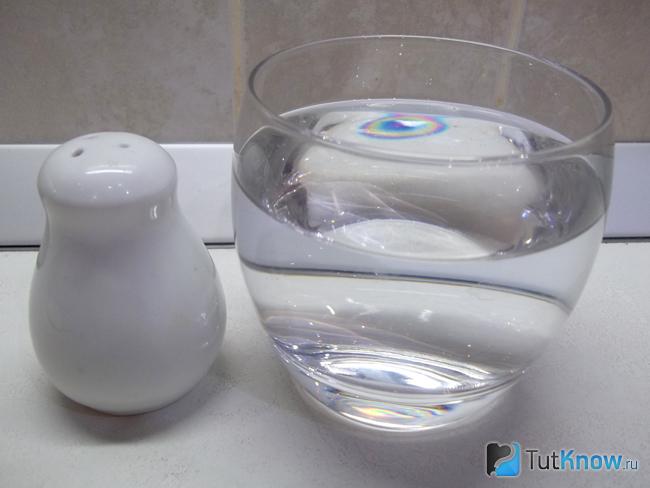
1. Dilute salt in water at a temperature of 50 degrees. Stir until it is completely dissolved.
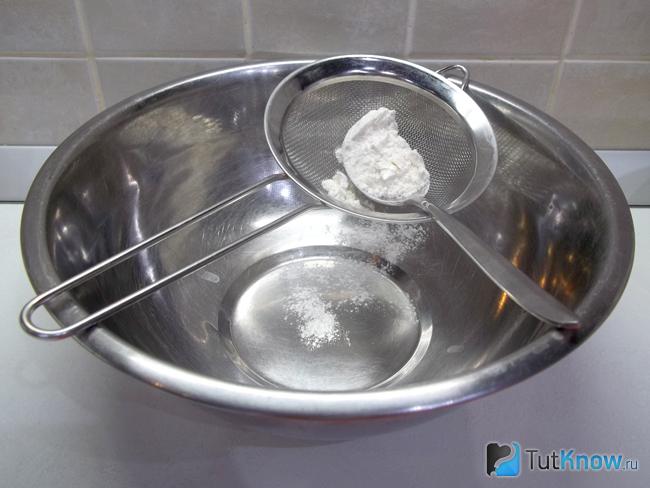
2. Sift flour through a fine sieve into a mixing bowl.

3. Next, pour in warm salted water.

4. Then add vegetable oil.
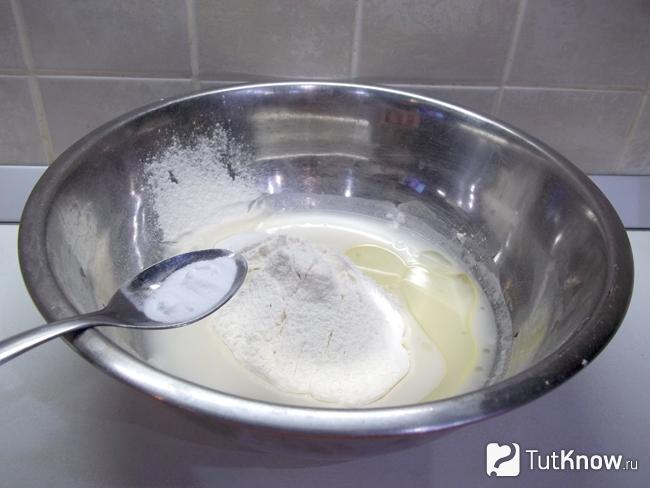
5. Add soda.
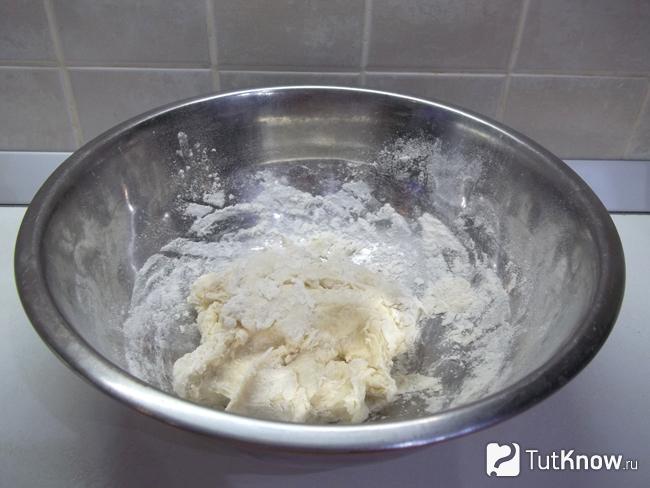
6. Start kneading the dough. At first it will seem that there is not enough liquid and you will want to add more. But you shouldn’t rush; during the kneading process, the dough will acquire the desired texture and stop sticking to your hands.
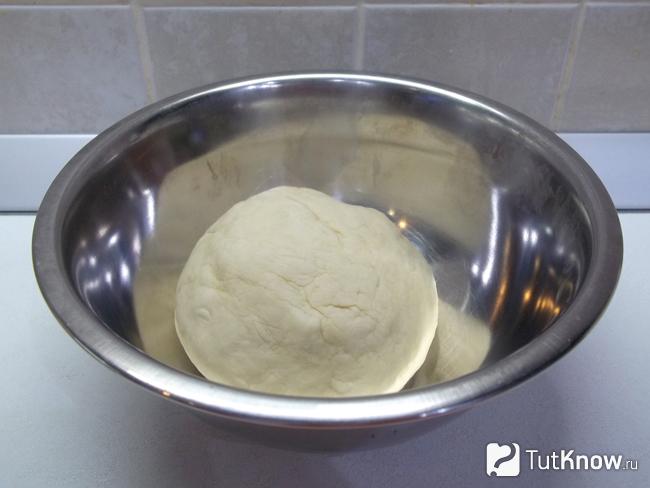
7. When the dough becomes elastic, form it into a ball and beat it well on the table about 10-15 times. To do this, lift the dough up and throw it back with force.
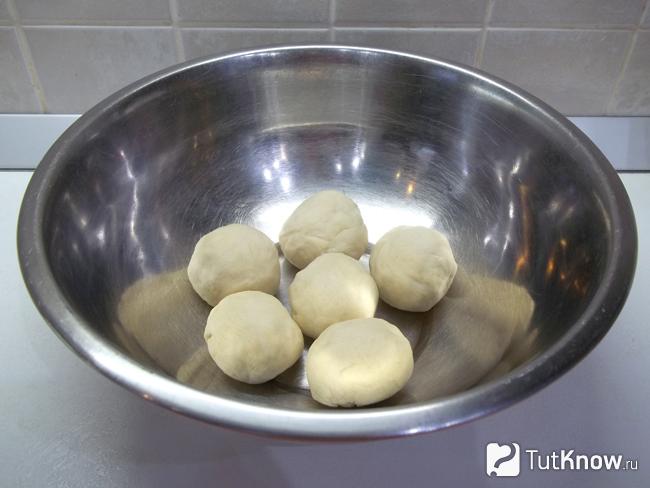
8. Divide the finished dough into 6 equal parts and form them into a round shape.
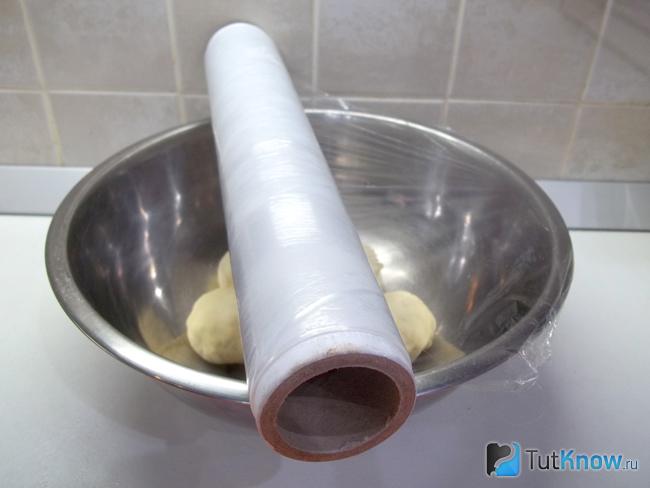
9. Place the dough in a bowl, cover them cling film and place in the refrigerator for an hour.
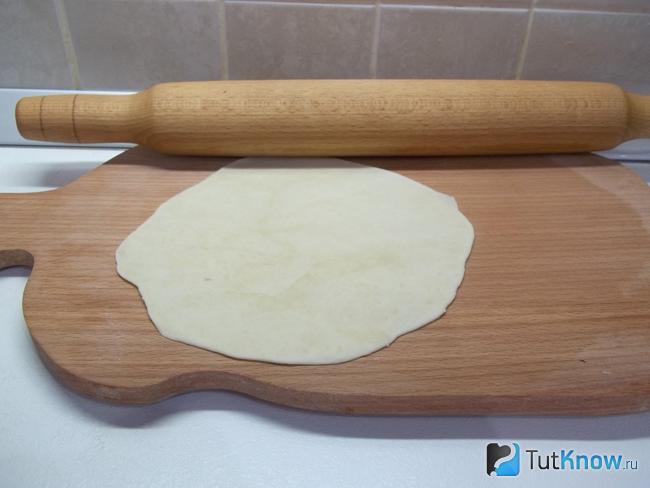
10. After this time, remove the dough from the refrigerator and allow it time to warm up to room temperature. After each ball of dough, form it into a layer with your hands, and then roll it out as thinly as you can with a rolling pin. It is most convenient to roll it out on a table covered with a tablecloth and sprinkled with flour.

11. Continue the work process with your hands. Place it on the back of your hands and stretch the dough over the edges, turn it over and pull again. Spread your arms to the sides, or hold one edge of the sheet on the table, and stretch the other, which is hanging down.
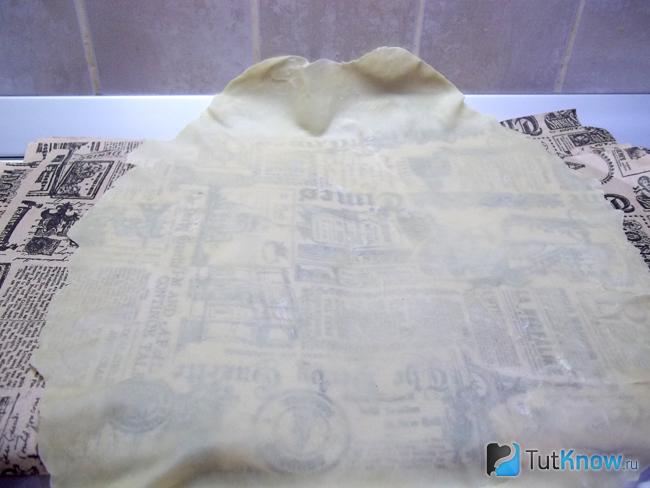
12. Optional ready dough place on parchment and trim the edges with a knife. But you can leave it and oval shape, if that doesn't bother you.

13. Everyone ready sheet Place the dough on parchment paper and roll it into a roll. Cover with a damp towel to prevent it from drying out. If you freeze it, wrap it in cling film and put it in the freezer. If not, after 15 minutes, unroll the dough and start baking. To do this, unfold each sheet and brush with melted butter using a pastry brush.
Watch also the video recipe on how to make phyllo dough.
]
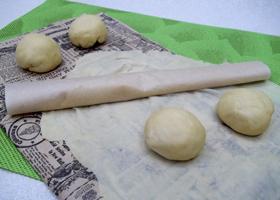
Philo is almost weightless, the finest dough which is used for making baked goods and desserts in oriental cuisine. They usually buy it ready-made, but since you want to try to cook it yourself, then this is especially for you detailed instructions How to make your own phyllo dough recipe at home. This was my first time making phyllo dough. I can immediately say that it is not easy, but if you try, it is possible - that’s exactly what I did, and I liked the way it turned out. Great care and patience when rolling are essential qualities when preparing phyllo. So let's get started.
Required:
- 700 g wheat flour fine grinding;
- 3 tbsp. spoons of potato starch;
- 1 tbsp. vegetable oil;
- 1 pinch of salt;
- 60 ml water;
- 1 egg.
You will also need cling film to cover the rolled out layers of filo.
Homemade filo dough recipe
1. I start the first stage of preparing phyllo by kneading simple unleavened dough. I add a little flour and sift it three times (!) into the container. We need a slide like this.

2. Add an egg.
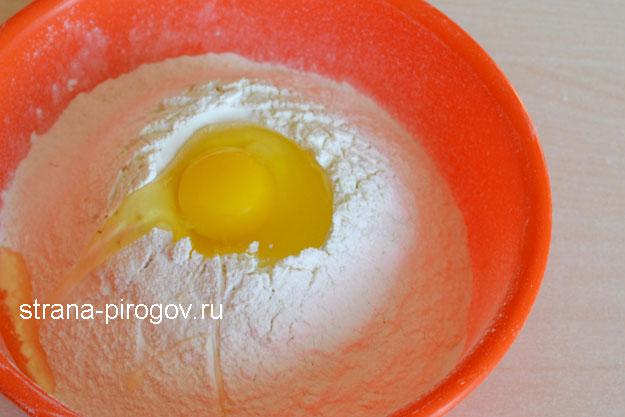
3. Pour warm water. I mix everything with a wooden spatula and place it on a cutting surface.

4. Next, I knead the dough with my hands, and very, very carefully - in the absence of a dough mixer. This process takes me at least 15 minutes, plus I forcefully throw the bun onto the table several times. Why do you need to knead for so long? Then, during the process, gluten develops in the dough - the proteins contained in the flour swell and become sticky, which makes it possible to stretch and roll out the dough thinly without fear that it will tear.
5. Thanks to all these manipulations, the result is quite pleasant to the touch and elastic dough– this is exactly what I need to make homemade phyllo.

6. I wrap the bun in cellophane or cling film and put it in the freezer. Yes, that’s it, and not for long – 5-7 minutes will be enough.
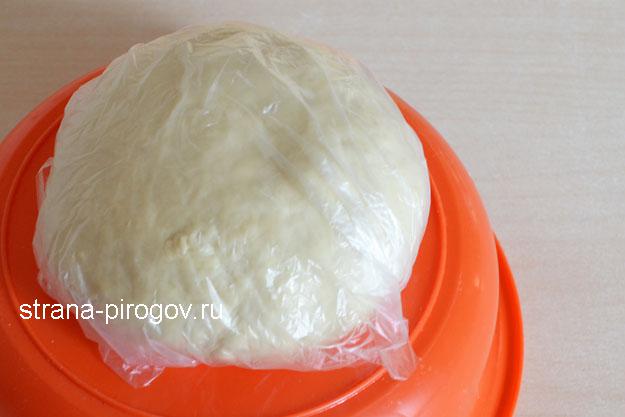
7. I get to the point important point in preparation. I'm converting unleavened dough into six small lumps, but I start working with three first. I sprinkle them with starch, and put the rest under film so they don’t get airy.
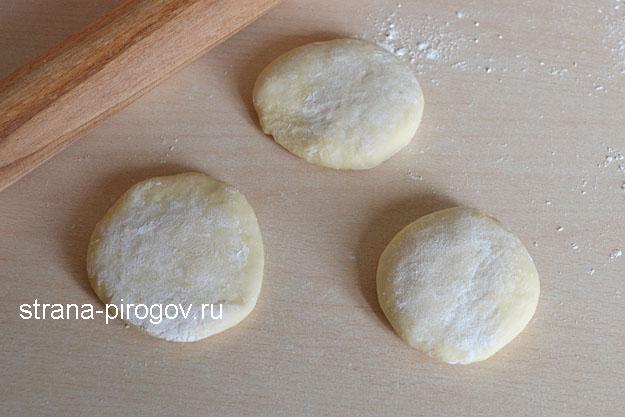
8. I slightly roll out each ball separately.

9. I stack the resulting cakes one on top of the other and continue rolling.
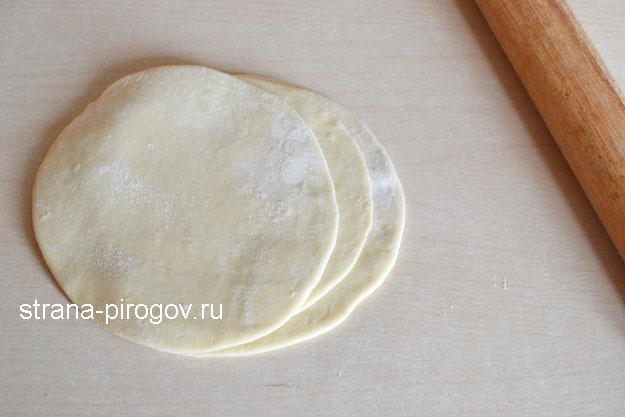
10. If necessary, sprinkle with starch, turn over and roll out again. Before my eyes, the dough begins to noticeably lighten and change consistency - the cakes are transformed into layers that are tender to the touch.
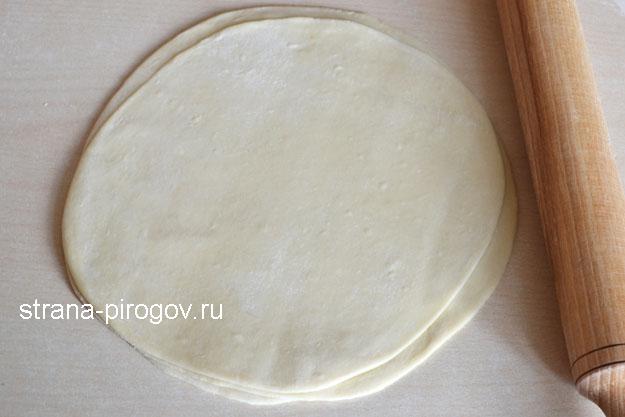
11. Next, I need to use a long rolling pin to turn each rolled out cake individually into a very thin layer - it’s most convenient to do this from the middle to the edge. Important! Once the rolling pin starts to stick, I dust the layers with potato starch again and again.
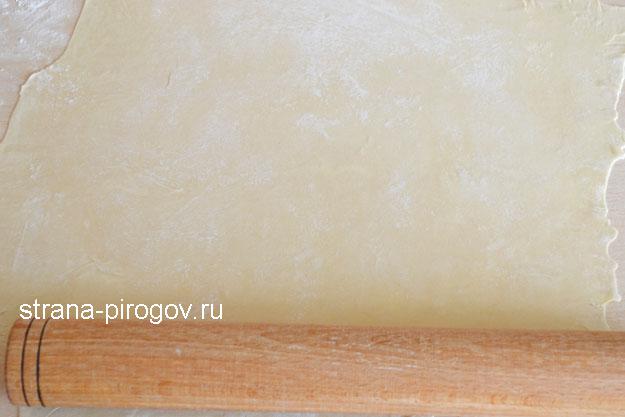
12. As a result, I have elastic and thin enough layers of dough through which you can read, for example, a large book text.

13. Sometimes during the cooking process, due to excessive effort, my layers tear a little. There’s nothing wrong with that; after all, it’s homemade dough. But if you plan to constantly and a lot prepare phyllo dough at home, then I advise you to buy a dough sheeter. It simplifies the process many times over.
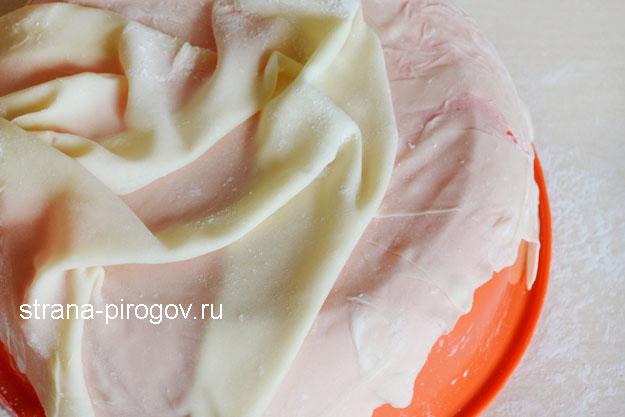
14. The rolled out layers must be covered with cling film to prevent them from drying out. There is a wide variety of filo baked goods. For my first try, I decided to bake a cheese roll. This is the technology here. The phyllo dough is laid out in layers - one layer on top of the other, each of which is greased melted butter. For the roll I used three sheets of phyllo. I sprinkled grated cheese on the second sheet, covered it with the third and rolled it into a roll. The phyllo dough is baked for a short time - 30 minutes at 200°. In order for the color of the finished baked product to be sunny, I make sure to grease the surface egg yolk. I approach cutting baked goods with special care - use a knife while it’s still hot, because it will be impossible to cut a cooled roll - it will simply crumble and that’s it.

With phyllo dough you can cook not only cheese rolls, but also strudel, baklava, various pies, tartlets and other crispy and incredibly tasty pastries.
In Turkey, when I first tried real baklava, I was delighted, tender dough, juicy, nuts.. – great combination, but then I couldn’t even think that this same baklava is more than 20 sheets of Filo dough soaked in honey and nuts.
Filo dough- This is a very thin dough, which is more used in Turkish or Greek cuisine. It is from this dough that the famous baklava, samsa, puff pastries, strundel. Filo dough is not very popular here, so it’s not so easy to buy it ready-made, although you can find it in stores. This dough can be prepared at home with minimal effort. In addition, homemade dough is several times cheaper than purchased dough. There are no “overseas” ingredients in its composition, everything is quite simple. The dough is easy to prepare and can be stored in the freezer for a long time. Note to housewives, you can prepare the dough, put the rest in the freezer and prepare baked goods of this or another type a little later.
1. Dilute the eggs with warm water and mix until smooth.
2. Add vegetable oil, salt and vinegar, mix again.
3. Then add flour and knead into a homogeneous dough.
4. Wrap the dough in cling film and leave at a temperature of 25-30 degrees for 1 hour.
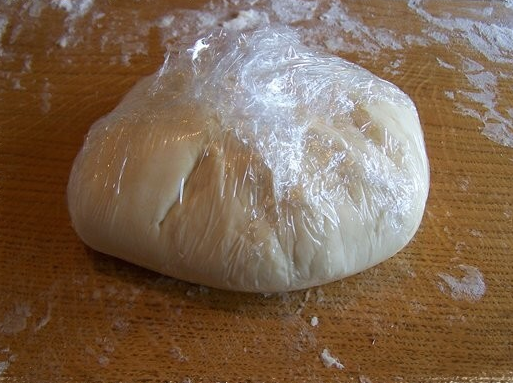
5. Then we begin to roll it out; to do this, take clean gauze and sprinkle it with flour.
Roll out the dough and stretch it carefully. The thickness of the dough should be no more than 1 mm. Almost transparent dough.

Depending on when baking will be made from it, it can be stored from several hours (at room temperature) to 2 months (in the freezer).
The dough is ready!
Bon appetit!
